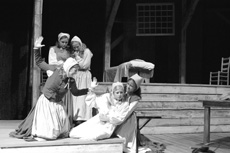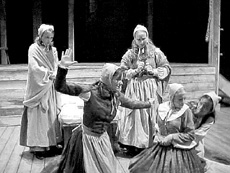 Tim Downer
Tim Downer Tim Downer
Tim Downer“The devil is loose in Salem,” Mary Warren, a character in Arthur Miller’s “The Crucible”, says at one point in the play.
It would appear that the devil has also found his way on stage at Northern Kentucky University in Director Samuel J. Zachary’s rendition of Miller’s 1953 work.
In “The Crucible,” Miller revisits a period in American history where many were being condemned falsely for being witches. With his fictional account of this historical period, there is some basis to truth; Miller brings forth the tale of the Salem Witch Trials of 1692.
The play begins with Williams (Linzie Greiwe) and her friends starting a lie to save their skins from a whipping by claiming that the devil made them dance and do evil things.
The lie spirals into a massive inquisition of many of the townspeople, who the girls claim they saw with the devil.
John Proctor (Andrew J. Bernhard), a farmer who just wants to mind his own business, is thrown into the town’s events when his wife Elizabeth (Andrea Scheu) is accused. The accuser is Williams, who at one point in the past had relations with Proctor.
It is through Proctor and the townspeople’s tale, that Miller shows how passion can sometimes overcome reason.
Keeping this in mind, Zachary fills his interpretation of Miller’s work with an ardor that flows from the stage into the audience’s very being.
Zachary’s direction can be seen in the actors’ portrayals of the characters. From the beginning, the audience senses exactly how each character is supposed to feel. At times the audience was on emotion overload. It was a little overwhelming. Throwing people on the ground and screaming to express frustration or anger is fine, but not in excess.
There were times when the actors expressed the rage in perfect harmony with the characters’ feelings. The scene when Bernhard’s (“Sweet Charity,” “Cyrano de Bergerac”) character found out that his wife had been accused, is a perfect example.
Bernhard’s acting was so convincing that I was ready to run on stage and shake some sense into the ignorant people who actually believed in witches and could accuse people who, in fact, were innocent.
Greiwe and her entourage of girls claiming to see the devil had me believe that the devil really had come down to torture them. One scene in particular, toward the end of the play, when all the girls were writhing on the ground, screaming, pointing to the air and staring horrified at what they claimed was before them, made me want to get up and give them some medicine to calm their nerves. I remember thinking, if Prozac had been invented back then, maybe the trials would never have come to pass.
Other actors did just as well when it came to developing the characters for the audience. Schue proved herself as she went from a distrustful wife – sitting straight-backed, answering abruptly and questioning constantly – to a wife who finally realized the goodness of her husband, hugging and understanding him.
John West (“Sweet Charity,” “Too Good to Say Goodbye”) played the overzealous Reverend Samuel Parris with as much fervor as the character deserves.
With his desire to prove the devil’s presence in the town, West shows the audience how his character loses himself in his zeal to provide the truth. It is not until the end that the audience understands how much Parris regrets his decision of being a maniacal man of righteousness when he falls to the ground, begging Proctor to repent because Parris realizes his mistake.
Even though West’s character might have made a mistake in judging those who were condemned, Gretchen Vaughn, the costume designer, didn’t slip one bit with the apparel that was shown on stage.
The costumes fit perfectly with the era. Puritan-like dresses and outfits set the mood without a doubt. The audience felt not only the emotions of the characters, but also what it was like to live in 1692.
With the help of costuming, acting and directing, NKU’s Department of Theatre and Dance kept Arthur Miller’s play “The Crucible” alive and well in the 2000s.

